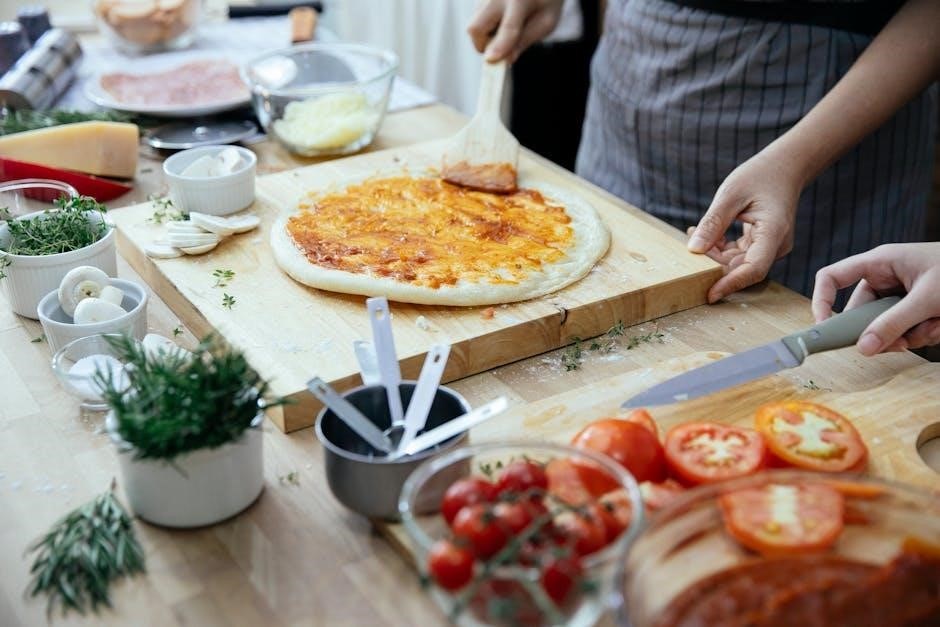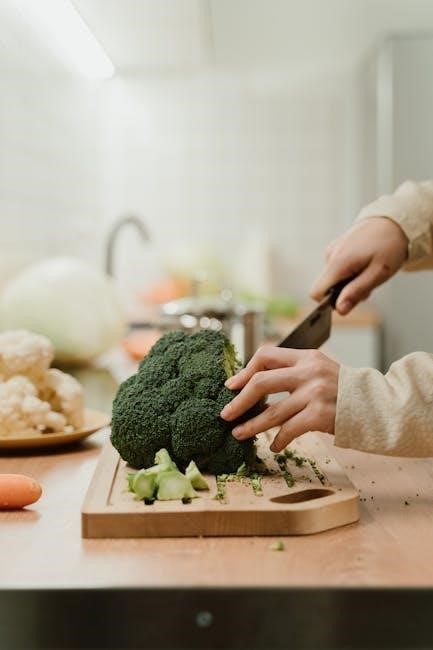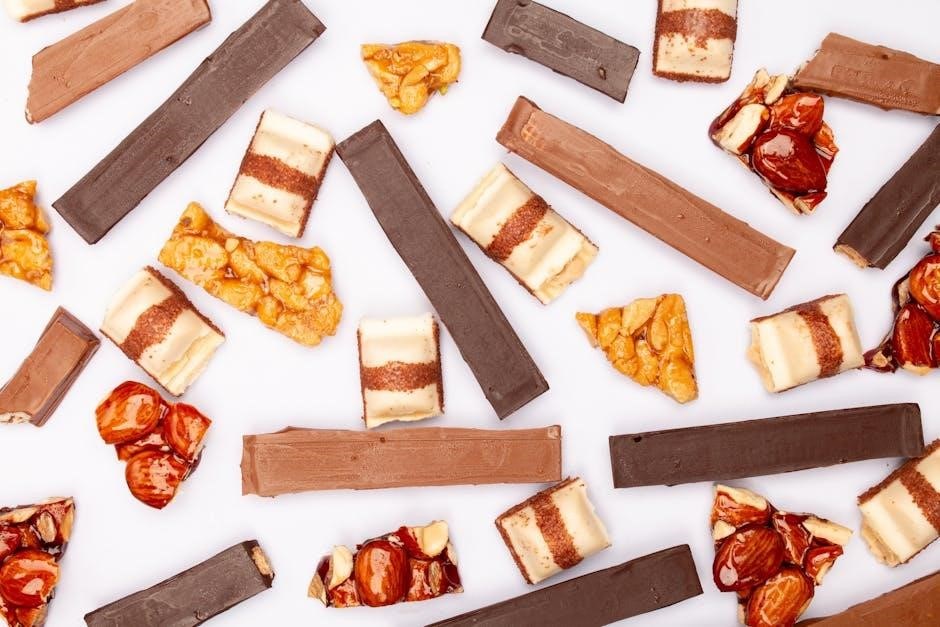Cauliflower pizza represents a groundbreaking innovation in the culinary world, transforming a simple vegetable into a delicious, gluten-free, and low-carb pizza base. It’s a favorite option for health-conscious foodies seeking a flavorful yet nutritious meal.
1.1 What is Cauliflower Pizza?
Cauliflower pizza is a creative twist on traditional pizza, where the crust is made by transforming cauliflower into a rice-like consistency. This innovative base is typically mixed with ingredients like eggs, almond flour, and seasonings to create a moldable dough. Baked until crispy, it serves as a gluten-free and low-carb alternative to conventional pizza crusts. The result is a flavorful and nutritious dish that appeals to health-conscious individuals and those with dietary restrictions. Its versatility allows for endless topping combinations, making it a keto-friendly and guilt-free meal option.
1.2 Benefits of Cauliflower as a Pizza Base
Cauliflower pizza offers numerous benefits, making it a revolutionary choice for health-conscious individuals. Its low-carb and gluten-free properties cater to those with dietary restrictions or preferences. Rich in fiber and essential vitamins, it provides a nutrient-dense alternative to traditional pizza crusts. The cauliflower base is also keto-friendly, appealing to followers of the ketogenic diet. Additionally, it supports weight management due to its lower calorie content compared to standard crusts. Its crispy texture and neutral flavor make it a versatile and satisfying option for various toppings. This innovative base is a perfect solution for those seeking a healthier, guilt-free pizza experience.

Ingredients and Tools Needed
To craft the perfect cauliflower pizza, essential items include cauliflower rice, almond flour, eggs, Parmesan, and seasonings. Tools like a food processor, baking sheet, and parchment paper are crucial for preparation and baking. Additional toppings and a pizza cutter enhance customization and serving. These elements ensure a seamless cooking experience, transforming cauliflower into a delicious, crispy crust.
2.1 Essential Ingredients for the Crust
The foundation of a great cauliflower crust begins with cauliflower rice, which can be fresh or frozen. Eggs are crucial for binding, while almond flour adds structure and crispiness. Parmesan cheese enhances flavor and texture, and seasonings like oregano, garlic powder, salt, and pepper provide a savory touch. These ingredients combine to create a sturdy, gluten-free base that’s both flavorful and nutritious. Optional additions like psyllium husk or arrowroot flour can improve texture, ensuring the crust holds well and bakes to a golden crisp. These simple yet impactful components make the crust a versatile and delicious option.
2.2 Additional Toppings for Customization
Customize your cauliflower pizza with a variety of toppings to suit your taste. Classic choices include tomato sauce, mozzarella cheese, and pepperoni, while fresh vegetables like mushrooms, olives, and spinach add flavor and nutrition. For meat lovers, bacon or ham can enhance the dish. Vegan options might feature vegan cheese or plant-based proteins. Don’t forget fresh herbs like basil or oregano for a burst of freshness. Whether you prefer hearty meats, vibrant veggies, or a simple yet satisfying combination, the toppings are endless, allowing you to create a pizza that’s uniquely yours. Personalize it to your liking!
2.3 Necessary Kitchen Tools and Equipment
To prepare cauliflower pizza, you’ll need a food processor or grater to transform cauliflower into a rice-like consistency. A baking sheet lined with parchment paper is essential for baking. A mixing bowl is required for combining the cauliflower dough, while measuring cups and a Processing cauliflower into rice consistency is the first step. Mix with ingredients like almond flour and eggs, then shape into a dough. This forms the crust base. Preheat the oven to 400°F (200°C) or 425°F (220°C) for optimal results. Line a baking sheet with parchment paper or a silicone mat to prevent sticking. Ensure the sheet is large enough to accommodate the crust size you desire. Some recipes suggest placing a wire rack on the baking sheet for better air circulation, which can enhance crispiness. Allow the oven to preheat fully before proceeding, as this step is crucial for achieving a golden-brown crust. Proper preparation ensures the crust cooks evenly and avoids sogginess. To create the base, start by breaking cauliflower into florets and pulsing them in a food processor until they resemble rice. Alternatively, grate the cauliflower using a box grater. For best results, cook the cauliflower rice by microwaving or boiling until tender. After cooking, allow it to cool slightly, then wrap it in a clean kitchen towel or cheesecloth to squeeze out excess moisture. This step is critical to ensure the crust isn’t soggy. Once dry, the cauliflower is ready to mix with other ingredients to form the dough. Once the cauliflower is processed and dried, combine it in a bowl with egg, almond flour, Parmesan cheese, garlic, and seasonings. Mix thoroughly until a sticky dough forms. Ensure all ingredients are well incorporated for a cohesive texture. If the mixture feels too wet, add a little more almond flour; if too dry, adjust with a bit more egg. This step is crucial for creating a crust that holds together when baked. Proper mixing ensures the dough will form a solid base for your pizza. Transfer the cauliflower dough to a parchment-lined baking sheet. Use your hands or a spatula to shape it into a circular or rectangular form, depending on your preference. Ensure the dough is evenly spread, maintaining a thickness of about 1/4 inch for a crispy crust. Gently press the edges to form a slight border, which helps contain the toppings. If the dough feels too fragile, let it rest for a few minutes before reshaping. Proper shaping is key to achieving a sturdy and evenly cooked crust. Preheat the oven to 400°F (200°C). Place the shaped crust on a parchment-lined baking sheet. Bake for 15-20 minutes, or until golden and crispy. Flip halfway for even cooking. Avoid overbaking to prevent burning. A well-baked crust sets the foundation for a delicious cauliflower pizza. Preheat the oven to 400°F (200°C). Place the cauliflower crust on a parchment-lined baking sheet. Bake for 15-20 minutes, or until the edges turn golden and the crust becomes crispy. Avoid overcrowding the sheet for even cooking. After 10 minutes, carefully flip the crust to ensure both sides are evenly baked. This step is crucial for achieving a sturdy base. Once pre-baked, the crust should be dry and slightly browned, ready for sauce and toppings. Proper pre-baking prevents sogginess and ensures a firm texture for the final pizza. Once the crust is pre-baked, spread a thin layer of your preferred sauce, such as marinara or tomato sauce, evenly over the surface. Be cautious not to overload the crust to avoid sogginess. Add your favorite toppings, including cheese, meats, or vegetables. Keep toppings light to maintain the crust’s integrity. Sprinkle with mozzarella or Parmesan for an authentic pizza flavor. Ensure toppings are evenly distributed to promote uniform cooking. Avoid excessive sauce or wet toppings, as they can make the crust soggy. This step sets the stage for a flavorful and well-balanced pizza. Place the pizza on the middle rack of the oven, ensuring even heat distribution. Bake at 425°F (220°C) for 10-15 minutes, or until the cheese is bubbly and the edges are golden. Keep an eye on the pizza to prevent overcooking. For a crisper crust, broil for an additional 1-2 minutes. Remove from the oven and let it cool slightly before slicing. This final bake ensures the toppings are heated through and the crust retains its crispiness. Proper baking time is crucial for achieving the perfect texture and flavor. For a perfect cauliflower pizza, ensure the crust is dry by patting excess moisture. Use parchment paper for even baking and to prevent sticking. Monitor oven temperature closely to avoid burning, and consider using an air fryer for a crisper finish. These tips enhance texture and flavor, making your cauliflower pizza a delightful meal. To achieve a crispy cauliflower crust, pat the riced cauliflower dry with a clean kitchen towel to remove excess moisture. Preheat the oven to 425°F (220°C) and line the baking sheet with parchment paper for even cooking. Bake the crust for 15-20 minutes until golden brown, ensuring it doesn’t burn. Avoid overcrowding the crust with toppings to maintain crispiness. For an extra crunch, cook the crust in an air fryer or pizza oven at a higher temperature. Monitor closely to ensure the edges don’t overcook. A crispy crust enhances the overall texture and flavor of your cauliflower pizza. To prevent a soggy cauliflower crust, ensure the riced cauliflower is thoroughly drained after cooking. Pat it dry with a clean kitchen towel or paper towels to remove excess moisture. Preheat the oven to 425°F (220°C) and line the baking sheet with parchment paper to promote even cooking. Avoid overloading the crust with wet toppings, as this can lead to sogginess. Use a light layer of sauce and cheese, and opt for well-drained toppings. Cooking the crust until golden brown before adding toppings also helps maintain crispiness and prevents moisture absorption. For an extra crispy crust, consider using an air fryer or pizza oven. Preheat the air fryer to 400°F (200°C) and bake the crust for 8-10 minutes until golden. Alternatively, a pizza oven can achieve a perfectly cooked crust in just 2-3 minutes at high heat. These methods enhance crispiness and texture, offering a more authentic pizza experience. Simply transfer the pre-baked crust to the air fryer or pizza oven, add toppings, and cook until bubbling. This optional step adds a professional touch to your cauliflower pizza creation.
Preparing the Cauliflower Crust
3.1 Preheating the Oven and Preparing the Baking Sheet
3.2 Processing Cauliflower into Rice Consistency
3.3 Mixing the Cauliflower Dough
3.4 Shaping the Crust

Baking the Crust
4.1 Pre-Baking the Crust
4.2 Adding Sauce and Toppings
4.3 Final Baking Instructions

Tips for the Perfect Cauliflower Pizza
5.1 Ensuring Crispy Crust
5.2 Avoiding Sogginess
5.3 Optional Air Fryer or Pizza Oven Methods



